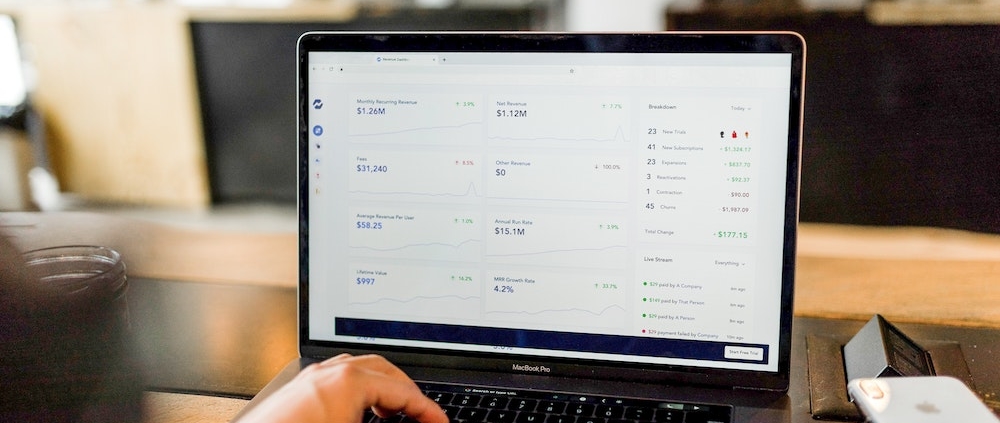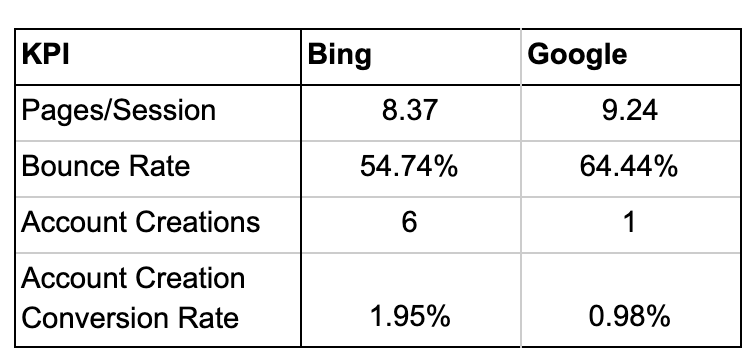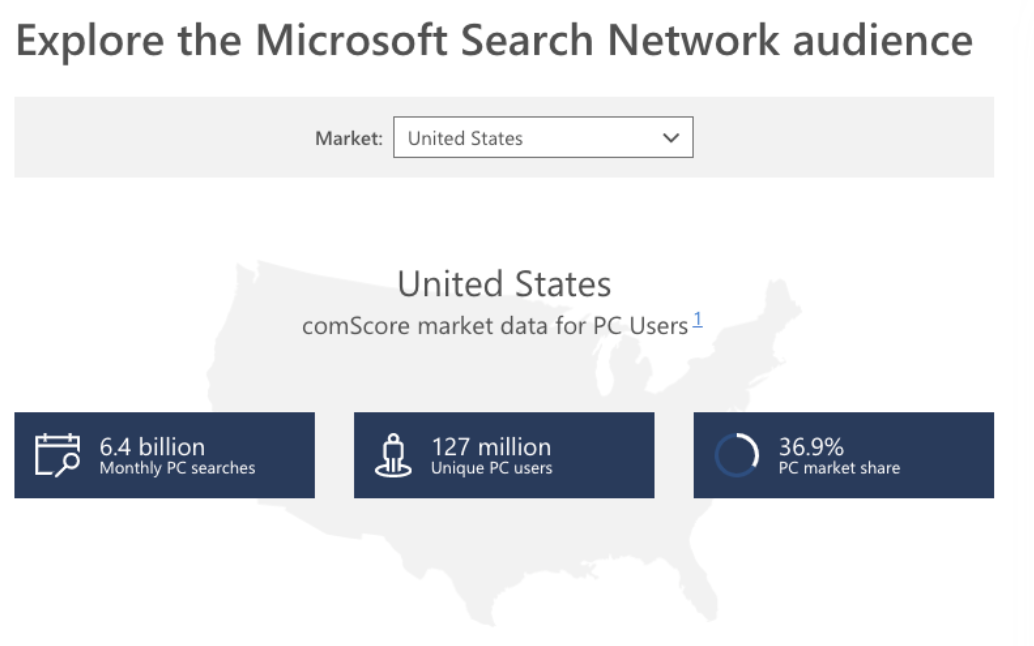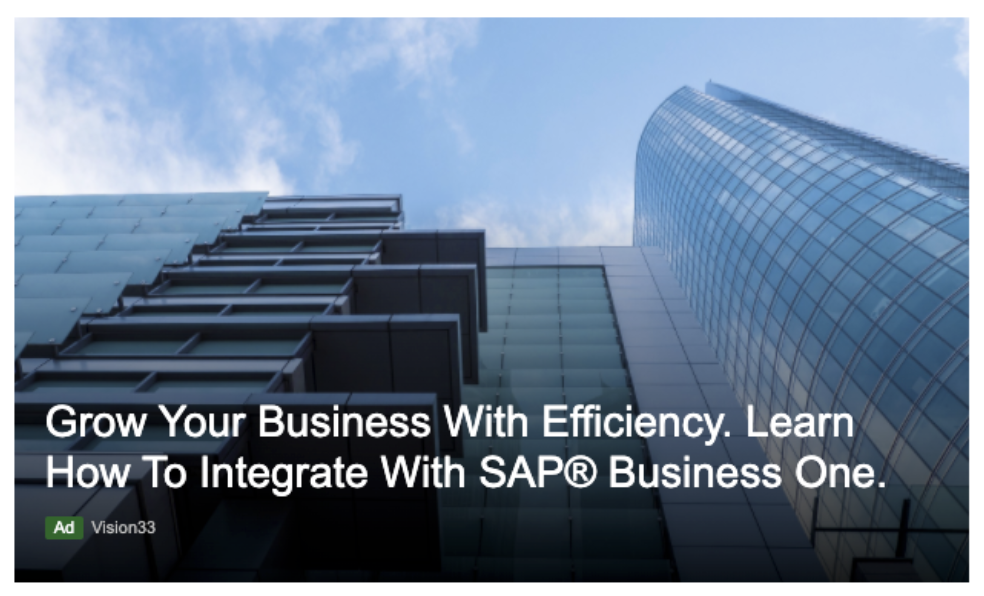4 Reasons You Should Be Using Microsoft Ads For Your Business
Microsoft Ads, formerly known as Bing Ads, is the often overlooked PPC platform that many marketers and businesses treat as a lower-budget extension of their existing campaigns that are running on Google Ads.
But as Microsoft Advertising Partners and veterans of the platform, we know the value that Microsoft Ads can bring, especially in certain industries.
In fact, when recently split-testing the exact same campaign and keywords across Microsoft Ads and Google Ads, we found more value from Microsoft Ads in multiple KPIs.
You can see this for yourself in the KPI table below:
This platform-based split test experiment was done alongside our partner, CITI Program. Essentially, we wanted to know which search network would provide higher quality traffic for CITI Program’s target market of research organizations searching for research-specific training courses.
Although Google eked out higher pages/session, Microsoft Ads had a lower bounce rate and much higher conversion rate.
Had we run this search campaign solely on Google, we may have paused, thinking that perhaps Search isn’t the right channel. Or, had we not split tested Google against Microsoft Ads, we may have never known that there was better performance to be had on the latter platform.
Now that you’re convinced Microsoft Ads is worth a try for your business, let’s take a look at a few of the benefits and efficiencies we’ve found in our recent experiments.
Enjoy Lower CPCs & Scale
“But who even uses Bing search?”
That’s one of the most common rebuttals when discussing advertising on Microsoft Ads, and I admit, I’ve fallen to this misconception before.
But in reality, Bing search accounts for 6.4 billion monthly PC searches and 36.9% of PC market share in the US.
Source: Microsoft Ads
Simply put, if you’re not advertising on Microsoft Ads, you are missing out on a whole lot of traffic.
And, the fact that there are less advertisers on Microsoft Ads than on Google Ads, means less competition, which also means lower CPCs.
So, you could be also missing out on cheaper search traffic.
There are anecdotes all over the internet of companies and agencies who have achieved lower CPCs on Microsoft Ads than on Google Ads when testing the same keywords, but we have multiple first-person examples where this has proven to be true.
In the scenarios below, we’ve been split testing the same campaigns and keywords with the same budget splits across Microsoft Ads and Google Ads during the same dates. In both cases, CPC is lower on Microsoft.
With more than enough search volume available and comparably low CPCs, experimenting with Microsoft Ads can help you identify opportunities to introduce your business via Search to a new audience that has the same high intent, but in many cases, costs a lot less to get to your site.
Access Premium Placements With Audience Ads
Although Microsoft Ads doesn’t have a traditional display network in the same vein as the Google Ads Display Network, Microsoft Ads does boast access to some top quality native ad placements, many of which are currently in beta, or ‘pilot’, for Microsoft Ads.
One such available pilot is the Audience ads pilot, which provides access to premium placements on msn.com, the Outlook inbox, and the Microsoft Edge browser.
It’s only been a short couple of weeks since we began our testing with Audience ads in Microsoft Ads, but so far, the results have been promising. I’ve also been enjoying the flexibility and appearance of the ads, which are automatically cropped to fit a variety of responsive placements.
Even better, Audience ads feature expansive job and industry specific targeting options ala fellow Microsoft product, LinkedIn. This makes Audience ads an excellent choice for B2B businesses looking to reach their targeted audience.
With these placement and targeting options available, we’ve been able to scale our prospecting efforts for Vision33, a B2B partner, by reaching their targeted industries and buyer job titles through Audience ads and maximizing clicks and impressions in a way that simply wasn’t possible through Search ads alone.
We’ve also seen early success in our retargeting efforts through Audience ads – a previous pain point of running campaigns on Microsoft ads.
Compared to our RLSA Search campaigns that are set up to target the same audience of previous site visitors, Audience ads have provided greater impressions and much lower CPCs, with a $0.47 average, compared to $5.12 via Search ads.
Same retargeting audience, but a huge difference in the cost to get them back to Vision33’s website. I’ll mark that as an early win for Audience ads!
Snag More Desktop Searches
You may have missed it earlier, but the chart linked earlier from Microsoft mentions that the Microsoft Search Network accounts for 36.9% of all PC aka desktop searches.
Here it is again, so we don’t forget.
In a world where mobile traffic is ever-increasing, it can be easy to overlook desktop traffic as we continue to optimize campaigns, landing pages, and entire websites for a “mobile-first” world.
But in some cases, like that of our B2B partner, Vision33, desktop traffic is still incredibly important.
In fact, when analyzing Vision33’s primary conversion (form fills) from January – June 2020, I noticed that desktop traffic converts much higher, across every single channel, than mobile traffic on the Vision33 website.
In fact, in some instances, desktop converts at a rate more than double that of mobile and/or tablet.
Knowing what we know about form fill conversion rates and desktop performance on Vision33’s website, coupled with what we know about Microsoft Search Network’s search market share of 36.9%, it’s clear to see why Microsoft Ads is working well for this B2B business.
Every business has different performance on its website, so “mobile-first” may not always be the best approach. If your business is converting higher on desktop than other devices, it’s time to increase that traffic by increasing your search volume through Microsoft Ads.
Save Time By Importing from Google Ads
If you like saving time automating things as much as I do, Microsoft Ads makes this easy by allowing and even encouraging you to import your ads from Google Ads.
If you’ve already begun running ads on Google Ads and have a campaign structure set up that you’re comfortable with, it is incredibly easy to import these campaigns into Microsoft Ads and even set the import on a schedule.
With this in mind, split testing Microsoft Ads vs. Google Ads, or even adding additional campaigns to your overall PPC mix becomes a lot easier. And, let’s face it, building campaigns in Google is still a much cleaner and more familiar process (sorry, Microsoft).
The import feature has allowed us to experiment with the Microsoft Ads channel fast, while making sure we are still serving top quality campaigns and ads, leaving more time for optimizations and data analysis.
Note: If you’re ready to test Microsoft Ads for your business and decide to import your existing campaigns from Google Ads, be sure to double-check the fine details, like device bid adjustments, time and days of week, audiences, etc.
Conclusion
Although Microsoft Ads may not be the first choice for businesses when deciding where to allocate their PPC funds, it certainly deserves a closer look, and preferably an experiment or three, to decide if it’s right for you and your business goals.
Certain industries thrive on the platform, and the lower CPCs make it incredibly enticing for those who are running out of room to scale their core search campaigns on Google, or are looking to increase high intent traffic for a lower cost through search campaigns.
If you’re ready to give Microsoft Ads a try, reach out to Tuff today.

Chris is a PPC Strategist based in Nashville, Tennessee. When he’s not scaling Google Ads & YouTube campaigns, he enjoys longboarding, tinkering with automation tools, and a little bit of gaming.












